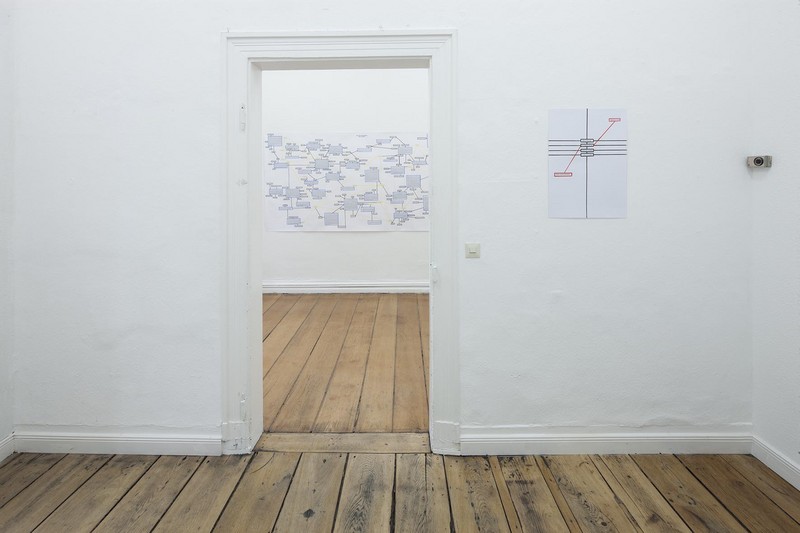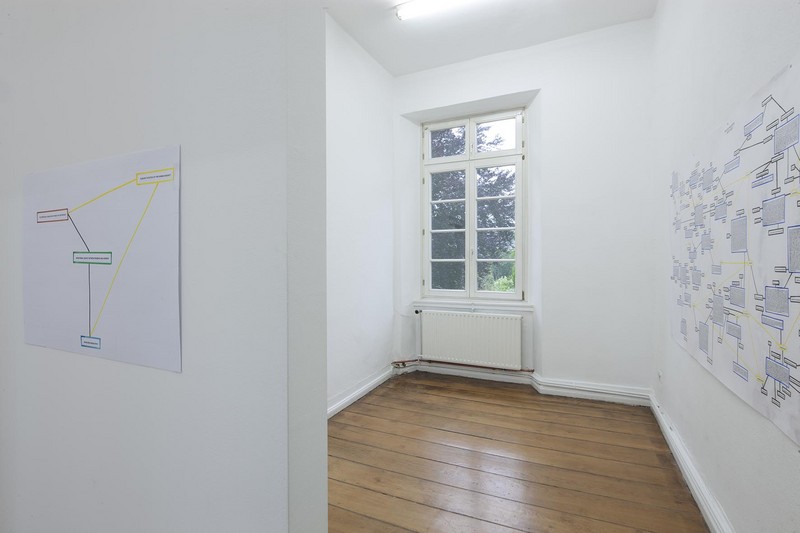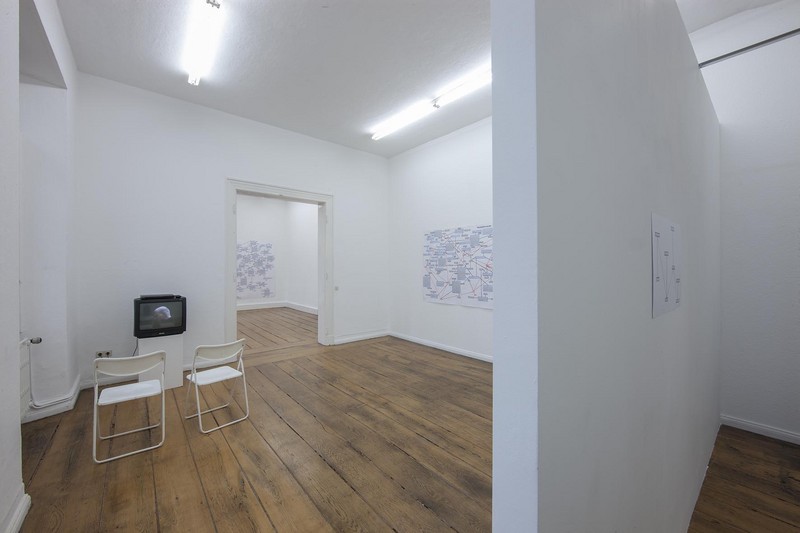Marcus Steinweg
01 Jun - 15 Jul 2012
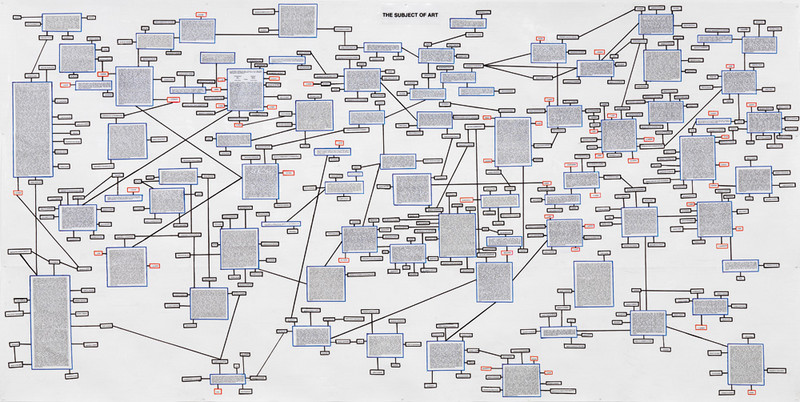
Marcus Steinweg, Diagram: The Subject Of Art, 2011, laser print, edding and tape on paper, 200 x 400 cm

Marcus Steinweg, Diagram: Art, Philosophy, Love and Thruth, 2012, laser print, edding and tape on paper, 133 x 280 cm

Marcus Steinweg, Diagram: Infinitesimal Subject Between Presence And Absence, 2011, laser print, edding and tape on paper, 42,4 x 59,8 cm
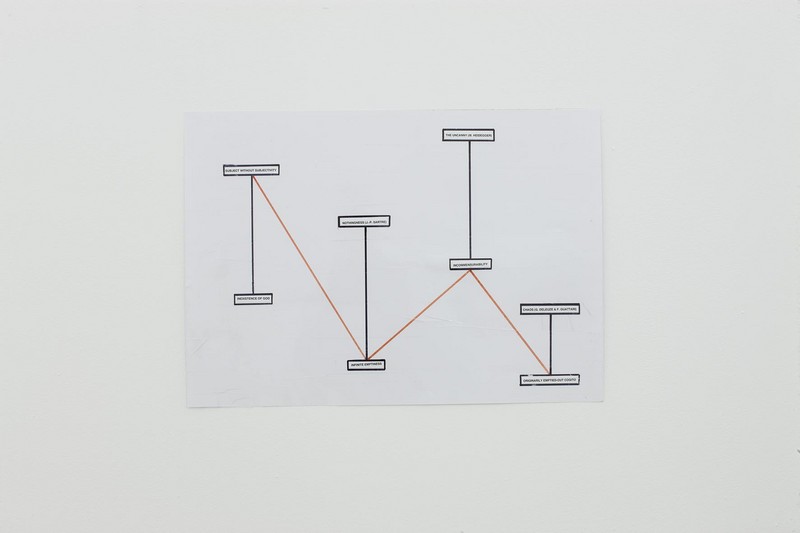
Marcus Steinweg, Diagram: Community Of Subjects Without Subjectivity, 2011, laser print, edding and tape on paper, 42,3 x 59,6 cm
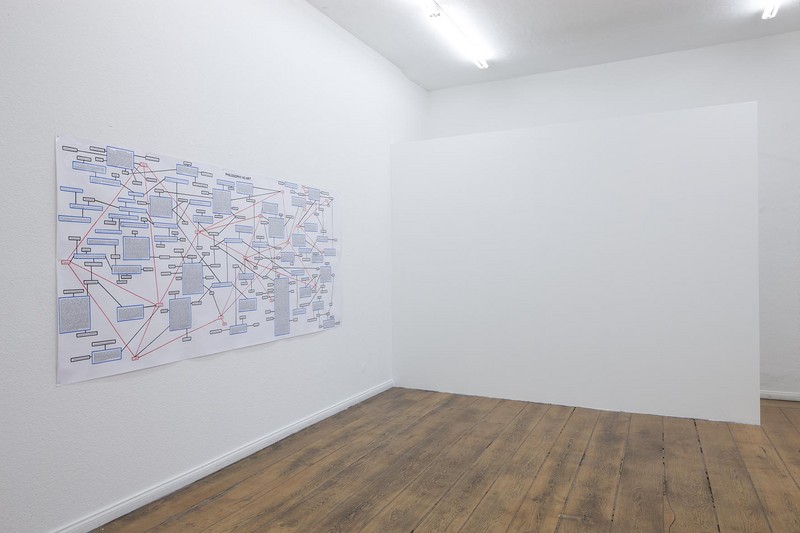
Marcus Steinweg, Diagram: Philosophy As Art, 2012, laser print, edding and tape on paper,
133 x 280 cm, installation view at Kunstverein Arnsberg 2012
133 x 280 cm, installation view at Kunstverein Arnsberg 2012
MARCUS STEINWEG
The Subject of Art
1 June – 15 July 2012
Kunstverein Arnsberg dedicates a solo show to the work of the German philosopher Marcus Steinweg.
In the exhibition, Steinweg shows new works – most of all terminological diagrams, but also a video – in which he formalizes his ideas. The diagrams consist of paragraphs of text, theoretical terms and concepts, and names of philosophers, which are compiled into paper collages and cross-referenced with marker pen. The connecting lines form geometric shapes and establish a network of thought, which visualizes and contextualizes Steinweg's philosophical position. The result are minimalist as well as highly complex collages, sometimes seemingly chaotic systems of order, which one can understand and view as recordings or abstract images of thought, diagrams, mind maps or concrete poetry.
Steinweg's film "Believe me, I believe me" (2007) shows an audience during a reading. The voice is Steinweg's during a reading – the images of the audience, however, were taken during completely different events. Edited and presented so as to suggest the audience is listening to Steinweg, the film is debunked as fake, in which not the speaker, but the audience is at the center of attention. Self-irony and the attempt to explore new experiences in the actually alien domain of art between reality and fiction lead Steinweg to his own path, on which he is respectively perceived as a philosopher among artists or artist among philosophers.
Steinweg describes his diagrams as follows: 1) I make terminological diagrams. 2) Each diagram is the formalization of an idea. 3) The idea can be a single term, which is contextualized with other terms, or an ensemble of terms: a cloud of terms. 4) There is no term which is not already a cloud of terms. 5) Clouds of terms intensify transparency with intransparency, simplicity with complexity. 6) At times once can see through a cloud and everything is clear, at times the cloud interrupts the vision and one loses orientation. 7) The diagrams must be as clear as possible, but must not feign clarity. 8) It is never about producing “aesthetic surplus value”. 9) It is about a thought, about philosophy. 10) What is clear can only be right.
The foundation for Marcus Steinweg's work as shown at Kunstverein Arnsberg is his theory of the subject, as developed in a series of books (see bibliography):
“What is the human subject? How to think the subject after the death of the subject? Which parts of the subject have survived its deconstruction in philosophy, first and foremost in the second half of the 20th century? And if there continues to be a subject, if it continues to make sense to think man as subject (i.e. as an agent of a certain freedom, instead of a product of circumstances, culture, economy and history etc.) - what kind of subject are we dealing with? It is clear that it is a subject exposed to many a determination and heteronomy. Furthermore it is clear that it can hold its ground as a subject only in full confrontation with its status as an object. In the subject the dimensions of radical passivity and hyperbolic activity cross each other. The subject is the stage of this crossing. Translated into philosophical categories this means: the subject is the scene where the future intervenes with the past and the past determines the future. For a theory of art this means to compromise the illusion of immanence of pure art through a heterogenous moment, but in a way in which the work of art breaks with this heterogenity by integrating it into itself.
The heterogenous can be social reality, societal moment, which art cannot simply transcend in order to lock itself into an aestheticism of “l'art pour l'art”. At the same time art must claim a certain degree of incomensurability with this moment, not through ignorance, but through a heightened awareness which guarantees an infinitesimal autonomy in relation to all that is not art. Instead of bowing to the structure of immanence which is established reality, the universe of facts, art implies resistance to the given in order to appeal to an un-thought. It is this un-thought that I give a diagrammatic form.”
Books by Marcus Steinweg (selection):
- Bataille Maschine, Berlin: Merve Verlag 2003
- Subjektsingularitäten, Berlin: Merve Verlag 2004
- Behauptungsphilosophie, Berlin: Merve Verlag 2006
- Duras (with Rosemarie Trockel), Berlin: Merve Verlag 2008
- Politik des Subjekts, Zürich-Berlin: Diaphanes Verlag 2009
- Aporien der Liebe, Berlin: Merve Verlag 2010
- Kunst und Philosophie / Art and Philosophy, Cologne: Verlag der Buchhandlung Walther König 2012
Steinweg was born in Koblenz in 1971. His position becomes clear through numerous talks and publications, exhibitions and projects as well as his collaborations with artists such as Thomas Hirschhorn and Rosemarie Trockel. Steinweg edits the journal Inaesthetics with Merve. In 2011 he curated the exhibition “Kunst und Philosophie” (Art and Philosophy) at the Neue Berliner Kunstverein and currently devises the series of talks “Überstürztes Denken” (Precipitous Thinking) at Volksbühne Berlin.
The Subject of Art
1 June – 15 July 2012
Kunstverein Arnsberg dedicates a solo show to the work of the German philosopher Marcus Steinweg.
In the exhibition, Steinweg shows new works – most of all terminological diagrams, but also a video – in which he formalizes his ideas. The diagrams consist of paragraphs of text, theoretical terms and concepts, and names of philosophers, which are compiled into paper collages and cross-referenced with marker pen. The connecting lines form geometric shapes and establish a network of thought, which visualizes and contextualizes Steinweg's philosophical position. The result are minimalist as well as highly complex collages, sometimes seemingly chaotic systems of order, which one can understand and view as recordings or abstract images of thought, diagrams, mind maps or concrete poetry.
Steinweg's film "Believe me, I believe me" (2007) shows an audience during a reading. The voice is Steinweg's during a reading – the images of the audience, however, were taken during completely different events. Edited and presented so as to suggest the audience is listening to Steinweg, the film is debunked as fake, in which not the speaker, but the audience is at the center of attention. Self-irony and the attempt to explore new experiences in the actually alien domain of art between reality and fiction lead Steinweg to his own path, on which he is respectively perceived as a philosopher among artists or artist among philosophers.
Steinweg describes his diagrams as follows: 1) I make terminological diagrams. 2) Each diagram is the formalization of an idea. 3) The idea can be a single term, which is contextualized with other terms, or an ensemble of terms: a cloud of terms. 4) There is no term which is not already a cloud of terms. 5) Clouds of terms intensify transparency with intransparency, simplicity with complexity. 6) At times once can see through a cloud and everything is clear, at times the cloud interrupts the vision and one loses orientation. 7) The diagrams must be as clear as possible, but must not feign clarity. 8) It is never about producing “aesthetic surplus value”. 9) It is about a thought, about philosophy. 10) What is clear can only be right.
The foundation for Marcus Steinweg's work as shown at Kunstverein Arnsberg is his theory of the subject, as developed in a series of books (see bibliography):
“What is the human subject? How to think the subject after the death of the subject? Which parts of the subject have survived its deconstruction in philosophy, first and foremost in the second half of the 20th century? And if there continues to be a subject, if it continues to make sense to think man as subject (i.e. as an agent of a certain freedom, instead of a product of circumstances, culture, economy and history etc.) - what kind of subject are we dealing with? It is clear that it is a subject exposed to many a determination and heteronomy. Furthermore it is clear that it can hold its ground as a subject only in full confrontation with its status as an object. In the subject the dimensions of radical passivity and hyperbolic activity cross each other. The subject is the stage of this crossing. Translated into philosophical categories this means: the subject is the scene where the future intervenes with the past and the past determines the future. For a theory of art this means to compromise the illusion of immanence of pure art through a heterogenous moment, but in a way in which the work of art breaks with this heterogenity by integrating it into itself.
The heterogenous can be social reality, societal moment, which art cannot simply transcend in order to lock itself into an aestheticism of “l'art pour l'art”. At the same time art must claim a certain degree of incomensurability with this moment, not through ignorance, but through a heightened awareness which guarantees an infinitesimal autonomy in relation to all that is not art. Instead of bowing to the structure of immanence which is established reality, the universe of facts, art implies resistance to the given in order to appeal to an un-thought. It is this un-thought that I give a diagrammatic form.”
Books by Marcus Steinweg (selection):
- Bataille Maschine, Berlin: Merve Verlag 2003
- Subjektsingularitäten, Berlin: Merve Verlag 2004
- Behauptungsphilosophie, Berlin: Merve Verlag 2006
- Duras (with Rosemarie Trockel), Berlin: Merve Verlag 2008
- Politik des Subjekts, Zürich-Berlin: Diaphanes Verlag 2009
- Aporien der Liebe, Berlin: Merve Verlag 2010
- Kunst und Philosophie / Art and Philosophy, Cologne: Verlag der Buchhandlung Walther König 2012
Steinweg was born in Koblenz in 1971. His position becomes clear through numerous talks and publications, exhibitions and projects as well as his collaborations with artists such as Thomas Hirschhorn and Rosemarie Trockel. Steinweg edits the journal Inaesthetics with Merve. In 2011 he curated the exhibition “Kunst und Philosophie” (Art and Philosophy) at the Neue Berliner Kunstverein and currently devises the series of talks “Überstürztes Denken” (Precipitous Thinking) at Volksbühne Berlin.


